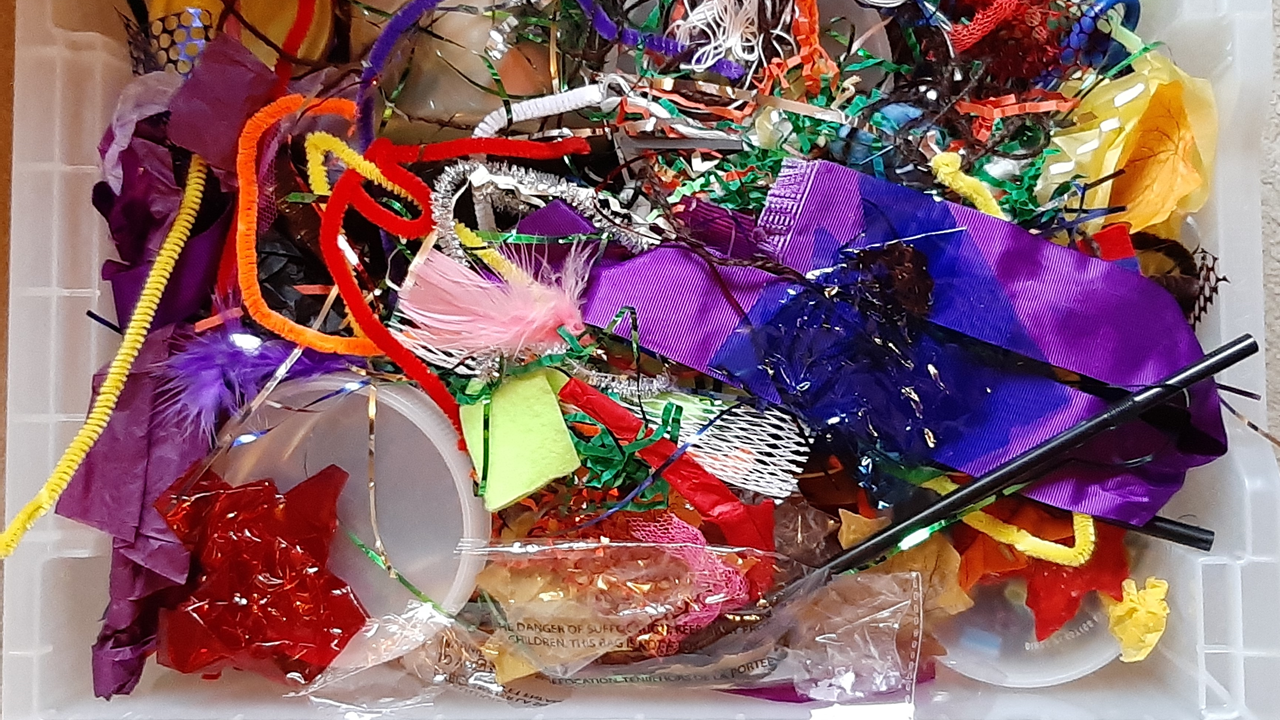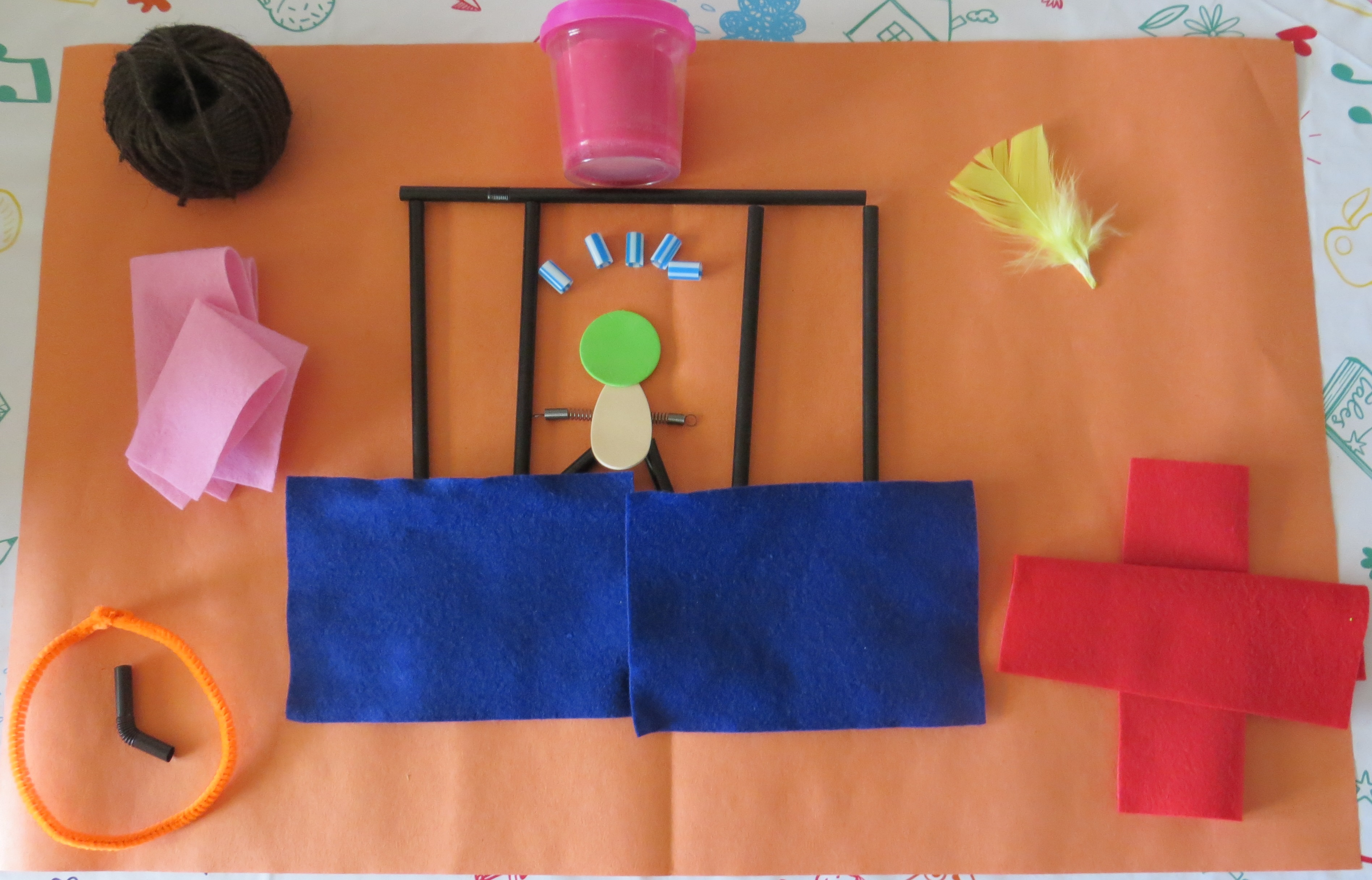What I mean by collage
Collage can be defined as a piece of art made by sticking various different materials, such as photographs and pieces of paper or fabric, onto a backing. I was interested in the origins of the word collage and discovered that it comes from the French “coller” meaning “to stick.” So, it would seem that sticking is an integral aspect of collage. I’m pretty sure many of us have spent time as children – and perhaps as adults, too – ripping out pictures from magazines and catalogues and sticking them down on a biggish sheet of paper. I know plenty of people who still do that including Andréa Watts who uses collage in a coaching context. For now, I’ll just tell you that I don’t tend to use glue. More about that in a minute.
The particular method of collage I use is one in which items are placed rather than stuck, which allows the movement of those items as the participant creates the collage. This is something my colleagues Amanda and Philip have written about and they emphasise the physicality of collage-creation and how the collage-creator has agency in the process. For me, it’s less about whether you can stick items down, and more about thinking why you might want to stick them down.
When I say items, I’m referring to arts and crafts materials, stationery or general “bits and bobs” you might have lying around. For my doctoral research, I put together a collage box which I took to participants’ homes, so they could create a collage. Early on in my use of collage as a research method, it was me who pre-determined which items were available. I had lots of things - of different colours, shapes, sizes and textures - in the box for people to delve into. The photo below gives an idea of how beautifully messy the box and its contents are:

Offering collage-creators a variety of materials like these allows them to pick and choose items which have textures and dimensions that paper, for example, doesn’t have. People can hold things in their hand, notice how they feel heavy, light, smooth, rough, etc. and use those features to convey meaning. More recently, I’ve facilitated sessions online in which participants have chosen and used their own items. That has allowed me to think more deeply about the choice of collage materials and who has a say in what those materials are.
How I’ve used collage
The 14 teachers and school leaders involved in my research used materials from the collage box, in the comfort of their homes, to express their response to a particular question: what does it feel like to be struggling as a teacher?
Watching people create collages is a privilege, seeing how they build up a visual expression of their experience. Some people are very concentrated and work on their collage in silence. Others might choose to have music on or chat with me. Some find it challenging but many find it cathartic. One teacher, who I will call Kathryn, kept returning to one item on her collage. Until I’d pointed it out, she hadn’t been aware of having moved a piece of blue felt - which was originally nearer the bottom of the page - up towards the centre of the page. I’ll explain the significance of this in a minute. Here’s a photo of Kathryn’s collage so you can see where the blue felt ended up:

I mentioned earlier that the type of collage I use doesn’t use glue. It’s been interesting to see how many people look around for the glue; some participants have even asked if they are allowed to use glue. Clearly, it’s not my place to allow or disallow this, so my response tends to be: what is it about the experience (e.g., of struggling) that you’d like to stick down? Kathryn’s example above is a useful example of how she was able to move one item around until she had settled on where she wanted it to be in her collage. Sticking down would, perhaps, have changed how she engaged in the process.
I’ve written elsewhere about Kathryn’s collage as an expression of her experience of struggling, but just to let you know that the blue felt represented the swelling waves of accountability in which Kathryn works. And I only know this, of course, because Kathryn was keen to talk about her collage once she’d created it. Perhaps now it is a bit clearer why the movement upwards – the rising waters – seemed significant. If you’d like to know more about what Kathryn’s collage means, I’ve written about it here or you can listen to this SAGE MethodSpace interview with Dr Janet Salmons where we wax lyrical about the wonders of collage, including Kathryn’s!
Why I use collage
I’ve been asked several times how I first came to use collage. I can’t actually remember, other than it is an approach used in the School of Education at the University of Hertfordshire where I did my
PhD research and I was intrigued. I was definitely a bit sceptical at first. It felt out of my comfort zone – I’m not arty, I don’t consider myself particularly creative, it was new and felt risky - and I wasn’t entirely sure how it would help me explore teachers’ experiences of struggling. There is a growing literature on the use of arts-based and creative methods - e.g. the recent
book on creative research methods in education by Helen Kara, Narelle Lemon, Dawn Mannay and Megan McPherson - but their use is still not particularly widespread.
Arts-based methods such as collage can help explore feelings, experiences and perspectives. Collage can enable a kind of thinking which is more visual than linear or linguistic and can help express things which are not easily put into words. I used collage-creation within research interviews. There are different roles that collage can play, including being ‘tin-openers for talk’.
Collage as data
For me, the collage images are data in and of themselves, and I was keen not to privilege the spoken word over these creative expressions. This has implications for how the collage data are analysed which I have written about
here. I explore the individual elements of the collage, in terms of their colour, position and distribution across the page. I also look for literal representations in the collages, such as the cage Kathryn has placed herself in. Finally, I look for connections – and disconnections or ambiguities - between what participants verbalise about their experience and how they’ve represented that experience visually.
Sharing my love of collage
Earlier I talked of my passion for collage. The more I explore this creative research approach, the more I realise that I actually love collage. I enjoy sharing how collage can be used in research settings and have facilitated in-person and online events with students and researchers from a range of disciplines. In February 2022, I led a whole-day online course that introduced the theory of collage, guided attendees in experiencing collage-creation and offered ideas of how to analyse collage data. If you’re intrigued and want to know more, then you might be interested in joining me in
June 2022 for an online Summer School all about collage at the University of Manchester.
Some final thoughts…
I now wonder why I was ever sceptical about using an arts-based method like collage. Yes, it was unfamiliar and felt a bit strange, but if we think about it, all research methods can feel a bit uncomfortable when we first use them. I mean, crafting a questionnaire isn’t exactly easy. Pulling together a schedule for a semi-structured interview takes lots of thought and consideration. Slowly, collage is finding its place amongst other qualitative research methods. I’m not saying it’s suitable for all research questions, but I do feel that it shouldn’t be dismissed out of hand either.
When I first created a collage, I was blown away by what it was re-presenting; the hyphen is deliberate – I was being re-presented with a visual metaphor of my lived experience. I’ve known participants who thought at first that collage was ‘fluffy and bonkers’ but have then gone on to value the unspoken power of the collage-creation process.
Perhaps you’ll dip your toe into the collage waters one day, too? I’d love to know how that feels for you.
Author Bio: Dr Suzanne Culshaw is a post-doctoral Research Fellow in the School of Education at the University of Hertfordshire. Her most recent research involvement was in an Erasmus+ funded project called ENABLES, which explored the use of arts-based and embodied methods to support the development of leadership in schools. Her doctoral research explored what it means to be struggling as a teacher, for which she invited participants to create collages. Over the past five years, Suzanne has presented her methodological thinking about using collage at numerous online and in-person conferences and workshops in the UK and in German-speaking countries. Suzanne is very happy to be contacted via Twitter @SuzanneCulshaw or email [email protected]
1 MacBeath, J., 2002. The Self-Evaluation File: good ideas and practical tools for teachers, pupils and school leaders. Glasgow: Learning Files Scotland, Glasgow.
Acknowledgements: Suzanne is very grateful to the School of Education, University of Hertfordshire, England, for providing her with a fully-funded 3-year PhD studentship, which supported her whilst she conducted her doctoral research.